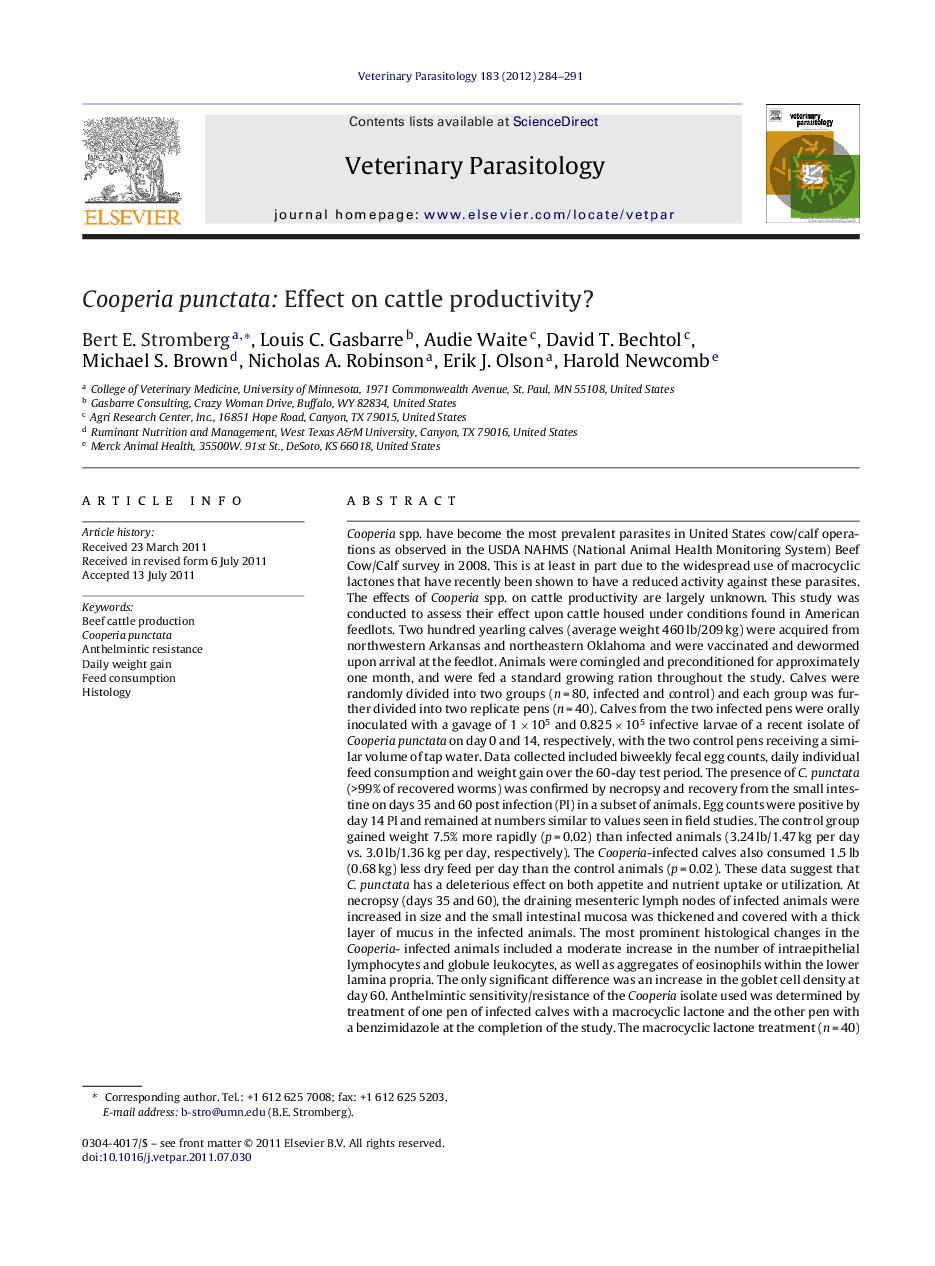| کد مقاله | کد نشریه | سال انتشار | مقاله انگلیسی | نسخه تمام متن |
|---|---|---|---|---|
| 5805553 | 1555718 | 2012 | 8 صفحه PDF | دانلود رایگان |

Cooperia spp. have become the most prevalent parasites in United States cow/calf operations as observed in the USDA NAHMS (National Animal Health Monitoring System) Beef Cow/Calf survey in 2008. This is at least in part due to the widespread use of macrocyclic lactones that have recently been shown to have a reduced activity against these parasites. The effects of Cooperia spp. on cattle productivity are largely unknown. This study was conducted to assess their effect upon cattle housed under conditions found in American feedlots. Two hundred yearling calves (average weight 460 lb/209 kg) were acquired from northwestern Arkansas and northeastern Oklahoma and were vaccinated and dewormed upon arrival at the feedlot. Animals were comingled and preconditioned for approximately one month, and were fed a standard growing ration throughout the study. Calves were randomly divided into two groups (n = 80, infected and control) and each group was further divided into two replicate pens (n = 40). Calves from the two infected pens were orally inoculated with a gavage of 1 Ã 105 and 0.825 Ã 105 infective larvae of a recent isolate of Cooperia punctata on day 0 and 14, respectively, with the two control pens receiving a similar volume of tap water. Data collected included biweekly fecal egg counts, daily individual feed consumption and weight gain over the 60-day test period. The presence of C. punctata (>99% of recovered worms) was confirmed by necropsy and recovery from the small intestine on days 35 and 60 post infection (PI) in a subset of animals. Egg counts were positive by day 14 PI and remained at numbers similar to values seen in field studies. The control group gained weight 7.5% more rapidly (p = 0.02) than infected animals (3.24 lb/1.47 kg per day vs. 3.0 lb/1.36 kg per day, respectively). The Cooperia-infected calves also consumed 1.5 lb (0.68 kg) less dry feed per day than the control animals (p = 0.02). These data suggest that C. punctata has a deleterious effect on both appetite and nutrient uptake or utilization. At necropsy (days 35 and 60), the draining mesenteric lymph nodes of infected animals were increased in size and the small intestinal mucosa was thickened and covered with a thick layer of mucus in the infected animals. The most prominent histological changes in the Cooperia- infected animals included a moderate increase in the number of intraepithelial lymphocytes and globule leukocytes, as well as aggregates of eosinophils within the lower lamina propria. The only significant difference was an increase in the goblet cell density at day 60. Anthelmintic sensitivity/resistance of the Cooperia isolate used was determined by treatment of one pen of infected calves with a macrocyclic lactone and the other pen with a benzimidazole at the completion of the study. The macrocyclic lactone treatment (n = 40) did not remove the parasites (FECRT = 8.8%), while treatment with a benzimidazole was very effective (FECRT = 98.1%). This study demonstrated that C. punctata has a significant effect on cattle productivity, both reduced weight gain and decreased feed intake compared to controls.
Journal: Veterinary Parasitology - Volume 183, Issues 3â4, 10 February 2012, Pages 284-291